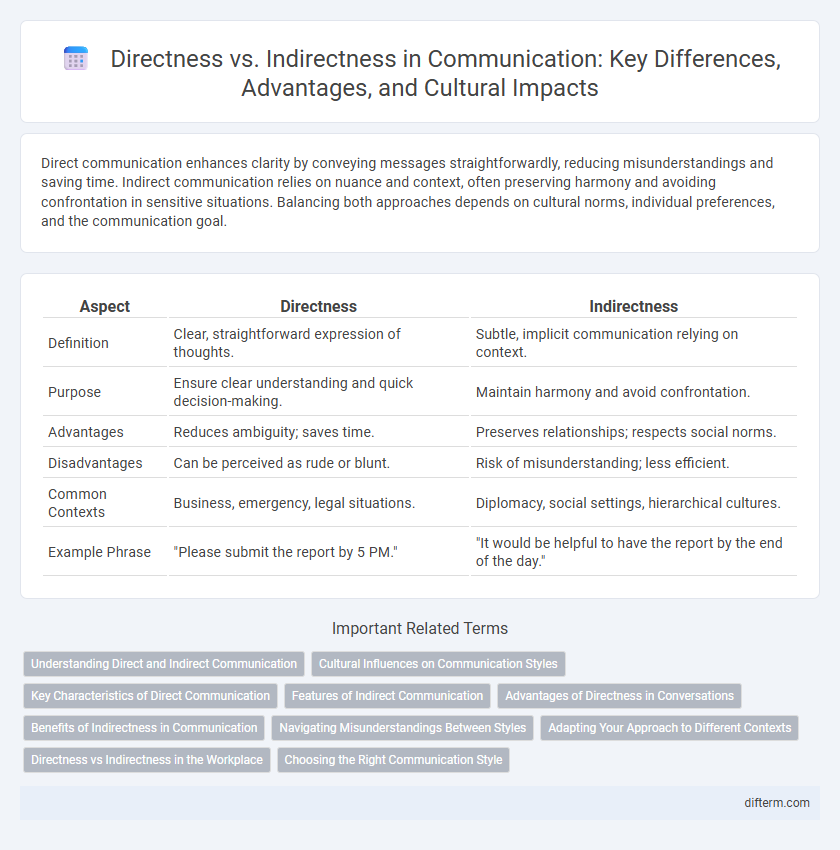Direct communication enhances clarity by conveying messages straightforwardly, reducing misunderstandings and saving time. Indirect communication relies on nuance and context, often preserving harmony and avoiding confrontation in sensitive situations. Balancing both approaches depends on cultural norms, individual preferences, and the communication goal.
Table of Comparison
| Aspect | Directness | Indirectness |
|---|---|---|
| Definition | Clear, straightforward expression of thoughts. | Subtle, implicit communication relying on context. |
| Purpose | Ensure clear understanding and quick decision-making. | Maintain harmony and avoid confrontation. |
| Advantages | Reduces ambiguity; saves time. | Preserves relationships; respects social norms. |
| Disadvantages | Can be perceived as rude or blunt. | Risk of misunderstanding; less efficient. |
| Common Contexts | Business, emergency, legal situations. | Diplomacy, social settings, hierarchical cultures. |
| Example Phrase | "Please submit the report by 5 PM." | "It would be helpful to have the report by the end of the day." |
Understanding Direct and Indirect Communication
Direct communication emphasizes clarity and explicit expression of thoughts, making intentions easily understood and reducing misunderstandings. Indirect communication relies on context, tone, and nonverbal cues to convey meaning, often preserving harmony and avoiding confrontation. Understanding the balance between directness and indirectness enhances effective interpersonal interactions across diverse cultural settings.
Cultural Influences on Communication Styles
Cultural influences significantly shape communication styles, determining the preference for directness or indirectness in interactions. High-context cultures, such as Japan and Arab countries, often favor indirect communication to maintain harmony and avoid confrontation, relying on implicit messages and nonverbal cues. Low-context cultures like the United States and Germany prioritize direct communication, emphasizing clarity, explicitness, and straightforwardness to convey information efficiently.
Key Characteristics of Direct Communication
Direct communication is characterized by clear, concise language that conveys messages unambiguously, minimizing the risk of misunderstandings. Speakers prioritize explicit statements, providing straightforward feedback and expressing intentions openly to ensure transparency. This communication style enhances efficiency in professional and personal interactions by fostering immediate comprehension and reducing the need for interpretation.
Features of Indirect Communication
Indirect communication often relies on context, nonverbal cues, and implied meanings rather than explicit statements. Features include the use of vague language, euphemisms, and hints to maintain harmony and avoid confrontation. This style is common in high-context cultures where preserving relationships takes precedence over directness.
Advantages of Directness in Conversations
Directness in conversations enhances clarity by reducing misunderstandings and ensuring that messages are received as intended. It fosters efficiency, allowing discussions to progress quickly without the need for interpreting implied meanings or reading between the lines. This straightforward approach builds trust and transparency, as participants feel confident about each other's intentions and viewpoints.
Benefits of Indirectness in Communication
Indirect communication enhances interpersonal relationships by promoting harmony and reducing conflict through subtlety and tact. It allows speakers to convey sensitive information more diplomatically, often preventing embarrassment and preserving face in social or professional settings. This approach improves mutual understanding in cultures valuing politeness and indirectness, facilitating smoother negotiations and cooperation.
Navigating Misunderstandings Between Styles
Direct communication emphasizes clarity and efficiency, reducing the risk of misinterpretation, while indirect communication relies on context and subtle cues that require careful attention to tone and body language. Navigating misunderstandings between these styles involves recognizing cultural and personal preferences, allowing flexibility to interpret implied meanings or explicit statements accurately. Effective communication demands adapting one's approach to the audience's expectations to bridge gaps and foster mutual understanding.
Adapting Your Approach to Different Contexts
Adapting communication style to direct or indirect approaches enhances clarity and rapport across diverse cultural and professional contexts. Recognizing context-specific preferences, such as high-context cultures favoring indirect communication and low-context cultures valuing directness, improves message effectiveness and reduces misunderstandings. Tailoring verbal and nonverbal cues to audience expectations ensures optimal engagement and collaborative outcomes in global and multicultural environments.
Directness vs Indirectness in the Workplace
Direct communication in the workplace promotes clarity, reduces misunderstandings, and accelerates decision-making by delivering messages in a straightforward manner. Indirect communication, often used to maintain harmony and show respect, relies on context and subtle cues, which can lead to ambiguity in multicultural teams. Balancing directness and indirectness is essential for effective collaboration, ensuring messages are understood without offending diverse colleagues.
Choosing the Right Communication Style
Selecting the right communication style depends on the context, audience, and cultural norms, with directness often preferred in professional settings for clarity and efficiency. Indirect communication can be effective in maintaining harmony and showing respect, especially in high-context cultures where subtlety and nuance are valued. Balancing directness and indirectness enhances message reception and minimizes misunderstandings, improving overall communication outcomes.
directness vs indirectness Infographic

 difterm.com
difterm.com